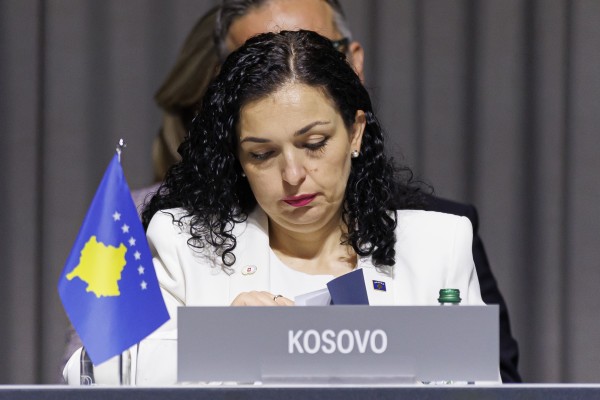The 2023 Slovak parliamentary election campaign made history, and not for the right reasons. For the first time, deepfakes played a role in the pre-election battle. Two days prior to the election, a video with an audio clip that allegedly featured Monika Tódová, a well-known journalist from independent news platform Denník N, and Michal Šimečka, the chairman of Progressive Slovakia party, circulated on social networks. The fake conversation never happened, but the video reached thousands of social network users anyway.
The “conversation” about electoral fraud was pure fabrication. But in a short video spreading just a few days before the Slovak election, the digitally generated voices of the journalist and a party chairman were heard talking about it. In the artificially manipulated video, known as a deep fake, a static image of the journalist and the politician is shown. The audio track is of poor quality and doesn’t sound authentic, but their words are also in the subtitles. Both involved immediately denied the authenticity of the conversation. Several fact-checking organizations and experts also confirmed the inauthenticity of the video.
According to press freedom groups, the deepfake involving Tódová is believed to be one of the first examples in the EU of artificial intelligence technology being used to manipulate the likeness of a journalist – and could offer a worrying portend of the future abuse of such tools to smear and discredit the media.
While deepfake videos or audio clips can be made by almost anyone with minimal effort, detecting them is not so simple. “There isn’t as of yet a really effective, accessible, and above all reliable tool for detecting AI-generated content, from audio to video to photos,” confirms ICJK Bellingcat journalist and researcher Michael Colborne. It is also challenging to determine how, exactly, it was created. “Whether it was created by someone uploading it and then using artificial intelligence to dub it, or whether someone trained artificial intelligence and then created an audio file from it, it’s impossible to say,” adds investigace.cz data analyst Josef Šlerka.
Tracing the path of the deepfake video is also problematic. The fact that it first started spreading from Telegram made looking into its origin even more difficult. Identifying the original source disseminating the clip with absolute certainty is almost impossible. However, it is clear that the recording could have served two purposes: to discredit a journalist and to provide evidence for the Kremlin’s narrative that the U.S. wants to manipulate the Slovak election results.
Pattern of discrediting attacks
Monika Tódová, a prominent figure in Slovak journalism from the newspaper Denník N, has faced smear campaigns before. According to the analysis of the Investigative Center of Jan Kuciak (ICJK), she was the most attacked journalist in the months prior to September’s 2023 parliamentary election. While this deepfake video surpassed previous tactics, she had been the object of these attacks long before.
A continuous smear campaign is being waged against Tódová involving not only politicians but also disinformation platforms. Constant discreditation, hate speech, and even surveillance – these are what she has had to face in recent years. And it is often the politicians who fuel them, including at their press conferences. In addition to these, she fell victim to a deepfake, which could be a completely new tool for smear campaigns in the future. The journalist has already taken legal action and with help of protection platform Safe.Journalism.SK filed a criminal complaint – on suspicion of defamation and criminal damage to the rights of others.
However, this deepfake video may have served a different purpose, too – fitting into the Kremlin narrative that the U.S. wants to manipulate the Slovak election results. The video, released a few days before Slovaks went to the polls, was distributed effectively on social networks and in emails. The most successful social network sharers of the fake video were politicians: former Supreme Court head and ex-minister Štefan Harabin and former MP Peter Marček. Both are strong advocates of pro-Kremlin positions and propaganda in the country. Marček himself visited annexed Crimea in 2018.
The ICJK’s findings show that the fake video initially became publicly widespread after being shared by Štefan Harabin’s Telegram account. However, he forwarded it from the hidden private account with the name “Gabika Ha.” The former justice minister’s account did not share content from this user by accident. He has done so at least 27 times. Moreover, analysis of the account’s content shows that the person using the account, “Gabika Ha,” must have accompanied the former justice minister in person at the Salamander Days in Banská Štiavnica in early September 2023. When asked if the profile could be associated with his wife, Gabriela (abbreviated Gabika) Harabinová, a name that bears similarity to “Gabika Ha,” Harabin hung up the call with ICJK’s reporter.
Despite initially surfacing on Telegram, the fabricated video spread to tens of thousands of users through Facebook. According to AFP fact-checker Robert Barca, who verifies the truthfulness of information on Slovak Facebook, it spread mainly through personal accounts, “like most viral false content on Facebook.” The most successful post, according to Barca, was that of a former member of the national council, Peter Marček.
Notably, the emergence of the deepfake video involving Tódová and Šimečka coincided with a press release from the Russian intelligence agency SVR published shortly before the video appeared, alleging US involvement in influencing the outcome of the Slovak elections. SVR intelligence chief Sergei Naryshkin accused the United States of instructing allies to cooperate with business and political circles “to secure the American-demanded voting results,” particularly aiming for “the victory of its proxy, the liberal party Progressive Slovakia (…)”. The press release also made mention of Michal Šimečka, the party’s chairman.
The night prior to the September 29 elections, the Slovak elections took center stage in the news broadcasted on the Russian state television network, Rossija 1. The report’s primary focus revolved around the potential for U.S. interference in the Slovak election outcomes. It was Štefan Harabin who echoed this theory on camera and, according to the footage, was the only one who gave an interview to Russian propaganda television.
Unless law enforcement authorities in Slovakia are able to identify the source of the disinformation attack, the ultimate motive behind the deepfake may never be established. However, as the use of AI tools become more readily available in the coming years, the likelihood of similar deepfake smearing attacks and AI-supported disinformation campaigns could increase, posing serious democratic questions not just for Slovakia, but for Europe and the world. As debates continue around the world about how AI will affect journalism and press freedom, this case represents a worrying example of the threats deepfake technology could pose, both now and in the future.
Karin Kőváry Sólymos works at the Ján Kuciak Investigative Centre (ICJK) in Slovakia
This article was commissioned by IPI as part of the Media Freedom Rapid Response (MFRR), a Europe-wide mechanism which tracks, monitors and responds to violations of press and media freedom in EU Member States, Candidate Countries, and Ukraine. The project is co-funded by the European Commission.




